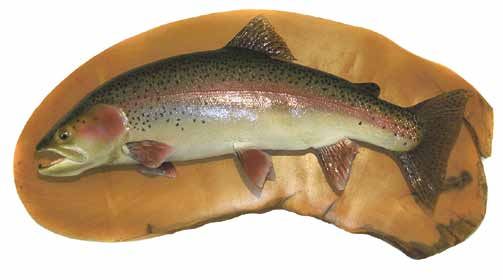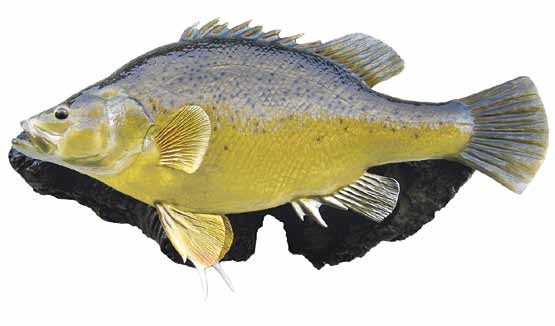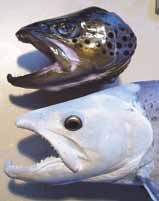Presented from Issue 96
Traditionally the age old art of fish taxidermy has involved the preserving, mounting and painting of the fishes skin and head to craft a life like trophy. In more recent times fibreglass fish reproductions or ‘repro’s’ have become available, offering the trophy hunter a viable alternative. Indeed, a well crafted repro can look as good and natural as a well made skin mount.
I was inspired to touch on this subject after hearing secondhand comments that ‘skin mounts don’t last!’ That’s true if the mount wasn’t made correctly in the first place. We’ve all seen the withered and colourless mounts hanging on pub and tackle shop walls, of hardly recognisable specimens caught 20 or 30 yrs ago, and in some cases not that long ago. Well, fish taxidermy has come a long way since those days, with modern techniques and products developed specifically for the industry there is no reason why a properly crafted skin mount should not last a lifetime.
I hope the following info will give you a better understanding of fish mounts and will help to make your choice a little easier when deciding to go ‘skin’ or ‘repro’.
Skin Mounts
This traditional method is best suited for freshwater fish such as trout or salmon. Sea fish tend to have more oily skins and can grow to huge proportions, making skin mounting very difficult. The skin mount is the preferred option for anglers who wish to have their actual fish preserved as a trophy and not just a copy of it.
Long term problems associated with a poorly made skin mount can include:
Colour fade - obviously noticeable as the dulling of paint and varnish over time, turning the mount to a brownish tone. Grease bleed - shown as yellow discolouration particularly around the head area, and stickyness along the back of the fish eventually causing paint to lift. Fin deterioration - curled, split, feathered and colourless fins. Shrinkage - seen as unsightly indentations and wrinkling particularly around the head. Yellowing - seen as overall discolouration of the mount. These are the most common and obvious problems with a poor mount.
The above troubles can be eliminated by proper techniques and products. Thoroughly defleshing and degreasing the fish skin before mounting will prevent most of the above, as well as using an exact artificial cast head replica. Also using the recommended paints and varnishes will ensure the beauty of your mount is not a temporary thing, but there to be admired for a lifetime. There are other procedures in the making process not mentioned here that will also ensure the longevity of the mount. At the end of the day, no corners can be cut otherwise it will show down the track, skin mounting should be a thorough and slow process.
One factor that often gets overlooked is care for your mount once it’s finished and displayed. Do not hang your mount in a very hot area, such as next to a wood heater in a fishing shack! No skin mount will endure extreme heat for extended periods for years. Be sensible and display it in moderately heated areas, also when dusting tell mum not to use hot water on it! A well done mount should look as beautiful and alive as the day you caught the fish. With the correct workmanship, products, and care by the owner then it will be there to admire for the next generation to come.
Fibreglass Reproductions
Fibreglass repro’s are suitable for all species of fish from minnows to makos! The robust nature of fibreglass can make this a great alternative to skin mounts as it will not suffer the problems of a poorly made skin mount. It’s the preferred method for most oily skinned sea fish.
A repro’ is a cast copy of the fish. None of the natural parts of the fish are used to make the mount except for maybe the fins or in some cases the teeth. Initially, a mould is made of the whole fish and a fibreglass blank or copy of the fish is cast from the mould. After preparation the cast is then painted the same colours as the original specimen.
The initial moulding of the fish is a most critical part of the making process. A poorly made mould will result in a poor fish repro that can look distorted and lacking detail. A good fibro cast from a properly made mould will show definite scale detail even on fish with small scales such as trout and salmon, and the repro should assume a natural pose of the fish, as if alive. If the mount has an open mouth, then inner mouth detail would be desired. One of the beauties of fibro moulding is that if done correctly all of the fish’s fine details can be reproduced on the mount. That, along with a professional paint job will make your trophy look natural and alive.
As with skin mounts, commercial paints and products are available, developed specifically for the purpose. Many brands of paint are available with a choice of pearl effects, shimmers and iridescents. A professionally made repro’ should look as natural as a well made skin mount, the two finished mounts should be difficult to tell apart. For anglers who like to release their trophy fish it may be worth mentioning that it’s possible to buy fibro fish blanks that just need painting.
Some overseas companies supply blanks to the customer’s requirements ie; fishes length and girth measurements. Many different species of fish are available, though I can’t vouch for the quality of them as I’ve never bought one.
Conclusion.
Nothing can be more rewarding than catching your beautiful fish, carefully handling it, taking a few photographs then releasing it to watch it swim away unharmed. And there’s also nothing wrong with keeping a fish for a trophy, in the scheme of things not many are kept for that purpose. However for those who do want to keep their catch to be mounted then there are a few things to consider. Take good reference pic’s of the fish when it is fresh from the water, your trophy will last a life time.
A well crafted fibreglass reproduction will look as good as any skin mount. This repro is a yellow belly perch from the Murray River.
The exact artificial head replica on the skin mount completely eliminates the possibility of unsightly shrinkage that can occur when using the natural head. this makes the taxidermist’s job a lot easier when painting the mount. Field care is important, look after your fish and it will reflect in the finished mount. Do not gut your fish, fold the fins to the body and wrap firmly with cling wrap then place on a flat surface in the freezer preferably with intended show side up. Your fish will stay fine stored like that. There is no immediate hurry to get it to the taxidermist.
Don’t rush into having the job done, do your homework, ask a few questions; how long has the taxidermist been operating? How much does he charge? How long does the job take? Have you seen his work around? What techniques does he use? You have to live with what you hang on the wall. It should be a trophy you are proud of. Finally, the type of fish and where you intend to display it will help you determine skin or fibreglass. Do your ground work and you should end up with a trophy that looks as beautiful as the day you caught it for years to come.
John Wilesmith

Rainbow trout skin mount. With correct methods and products your trophy will last a life time

A well crafted fibreglass reproduction will look as good as any skin mount. This repro is a yellow belly perch from the Murray River

The exact artificial head replica on the skin mount completely eliminates the possibility of unsightly shrinkage that can occur when using the natural head




